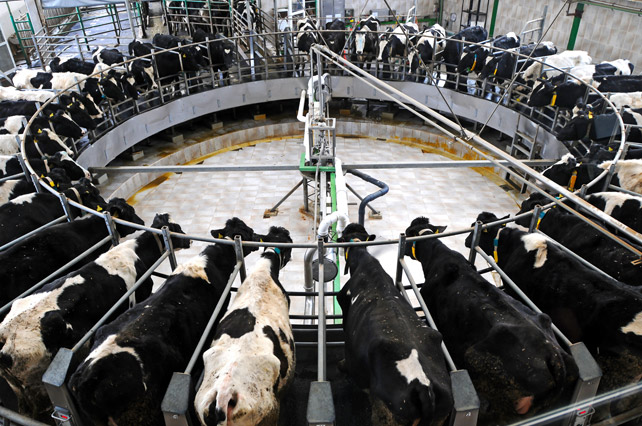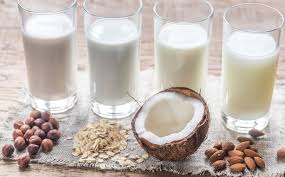Avoiding dairy? An update on ‘alternative’ dairy products
Dairy milk sales are down, but sales of plant “milk alternatives” are growing. There’s an ongoing fight in the U.S. for the right to call plant-based milk substitutes ‘milk’ with senators from dairy states Wisconsin and Indiana re-introducing a bill to “require enforcement against misbranded milk alternatives.” 
No doubt it’s because, in the United States, milk consumption has declined by 40 percent since 1975. The biggest milk processor in the US, Dean Foods, filed for bankruptcy recently — the Financial Times cites competition from milk alternatives as well as a declining share of children in the population.
Nutritionally, milk is a “combination food” — that is, it contains the three major nutrients necessary for good health — protein, fat, and carbohydrate. Milk is also a reliable source of micronutrients — vitamins and minerals. The Journal of the American College of Nutrition reports, “Despite their low energy contribution (10-13 percent of energy), milk and milk products contributed 47 percent of calcium, 42 percent of retinol (vitamin A), and 65 percent of vitamin D to the diets of children and adults. Milk and milk products were among the top sources of riboflavin, phosphorus, and vitamin B-12.”
But, consumers appear to be moving from cow’s milk to plant alternatives. According to Eater.com, “Options like almond milk, soy milk, rice milk, coconut milk, and hemp milk are beginning to demand more and more space on grocery store shelves as consumers have grown to embrace new flavors and vegan diets. Sales of nut and plant milks grew by 9 percent in 2018 and raked in $1.6 billion dollars, according to the Plant Based Foods Association. (That’s a relatively small slice of the overall milk market, but still, significant growth given that sales for regular, old dairy milk in the U.S. have been on a downward trajectory for nearly 10 years now.)
Why are people drinking less milk?
Health organizations including the World Cancer Research Fund and the American Heart Association strongly endorse a plant-based diet to help prevent and treat heart disease, stroke, obesity, high cholesterol, and type 2 diabetes.
Increasingly consumers have cited ethical concerns surrounding the consumption of dairy for avoiding milk — not in the least part because of the unnatural treatment of dairy cows on commercial “factory” farms.
Like humans, cows only produce milk after they have given birth, and must give birth to one calf per year in order to continue producing milk. Young heifers are barely a year old when they’re artificially inseminated for the first time. As soon as they give birth, their calves are taken away and the dairy cows lactate for 10 months, then forced to bear another calf, and the cycle repeats itself until the unnatural death of the cow. Although a domestic cow can live to 20 years, dairy cows are removed from the herd at only four or five years and marketed for beef.

Although dairy farming has been part of agriculture for thousands of years, today’s modern dairy cows are bred specifically to produce large quantities of milk and are killed after about 4-7 years and used for hamburger or pet food.
Alternatives to dairy
What about milk alternatives? You may want to avoid dairy for health and/or ethical concerns, but you want to be sure you’re choosing an alternative that delivers similar nutrients?
Lactose intolerant? Allergy to milk?
People with digestive issues like lactose intolerance or casein allergy (allergy to milk protein) have turned to milk alternatives in hopes they could enjoy the products without the gas, bloating, and other gastric problems associated with the inability to digest lactose. However, with commercialization come additives and a possibility that the solution has become part of the problem.
Most milk substitutes are thickened with agents like lecithin and carrageenan (a thickener processed from seaweed), guar gum, and other thickeners to produce a more acceptable, less watery product. USNews.com reports, “In order to thicken a non-dairy milk like coconut or almond into the expected texture of yogurt or ice cream, some substantial food science alchemy must take place. Some of these products rely on chicory root extract (inulin) in pretty significant doses to achieve a creamy mouth feel. While naturally derived and not unhealthy, inulin is highly fermentable (gas producing) by gut bacteria.

Read the ingredient label carefully – milk alternatives typically contain added sugars and gums.
A few brands of coconut milk ice cream also use poorly digested sugar alcohols like erythritol to sweeten their products. As a result, some of these products can produce a formidable amount of gas and diarrhea in sensitive individuals, especially those who consume larger portions.”
What about added sugar!
Plant “milks” are bland or even bitter and to increase taste acceptability, manufacturers tend to add a lot of sugar and/or artificial or sugar substitutes, in differing quantities and from different sources.
Savvy consumers will quickly learn the “code words” for sugar on the ingredient label.
Beware of any beverage carrying the label “drink” or “beverage” — that translates into added sugar or caloric sweetener. For your reference,
4 grams of azucar = 1 teaspoon of sugar.

There are a variety of plant-based milk alternatives from soy, rice, nuts, oats, and more.
Plant-based milk alternatives
I researched milk alternatives on CookingLight.com and ConsumerReports.com for information about ingredients, nutritional information, and taste.
Nutrition Comparison of Milk and Milk Alternatives — Serving Size 8 ounces (1 cup)
Cow’s Milk (1%) Nutrition Information
102 calories
8.2 g protein
2.4 g fat
31% of the recommended daily value for calcium
Pros: Good source of protein and important minerals and vitamins including calcium, vitamin D, and phosphorus. Regular milk contains no added sugar: lactose, or milk sugar, is the carbohydrate source. But watch out for flavor
Cons: Potential problem for those with lactose intolerance. Milk allergy prohibits the consumption of milk protein (casein). Ethical issues about commercially produced milk. Whole milk is high in fat (1 g per ounce).
Almond Milk Nutrition Information (unsweetened plain)
30-60 calories
~1 g of protein or less
2-2.5 g fat
Depending on the product, 30-35% of the daily value for calcium
Pros: When ingredients include only ground almonds and water, it’s low in calories and saturated fat.
Cons: Extremely low in protein, so care must be taken to boost protein throughout the day. Unsweetened is bland and some say bitter. Typically contains added thickeners.
Make your own by soaking and blending with water; sweeten to your own taste with organic honey or maple syrup and vanilla extract. Learn more here.
Coconut milk Nutrition Information (unsweetened)
40-80 calories
0 g protein
4.5-5 g fat
Depending on the fortification, 30-35% of the daily value for calcium
Pros: What’s sold in supermarkets are usually labeled “coconut beverage”. This is a watered-down version of rich and thick canned coconut milk, which is made from the pressing of fresh, ripe coconut meat. Coconut beverages are typically fortified with calcium, vitamin D, and vitamin B12 (read the ingredient label).
Cons: Zero protein! Most coconut beverages contain added sugar, but it’s possible to find flavored with vanilla, without added sugar. Also, you can make your own — click here to learn how. There is no shortage of fresh coconuts in Cuenca.
Soymilk Nutrition Information (low-fat, plain)
60-90 calories (depending on the brand)
4-6 g protein
1.5 – 2 g fat
Depending on fortification, 20-45% of the recommended daily value for calcium
Pros: Almonds are naturally high in protein and fat, and when fortified with vitamins B-12 and D. Nutritionally, fortified soymilk is the most similar to cow’s milk.
Cons: As with almond and coconut milk, it should be made only from soybeans and water but most have thickeners. Watch out for added sugar.
If you want to avoid GMO, be sure to read the label — might say “USDA Organic” (I see some products stamped with this certification in Supermaxi and Coral), or other non-GMO verified labels. Ecuador also has a regulation that any products that contain GM ingredients be labeled as such.
Rice Milk Nutrition Information (unsweetened)
90-130 calories (depending on the brand)
1 g protein
2-2.5 g fat
30% of recommended daily value for calcium
Pros: Rice is very non-allergenic.
Cons: Buy brands fortified with calcium, vitamins D and B-12, and iron. If buying rice milk imported from the U.S., know that most U.S. rice contains detectable levels of arsenic. Consumer Reports recommends drinking no more than ½ cup of U.S. sourced rice beverage daily, and not giving to children younger than 5.
Other milk alternatives are available, for example from cashews and hazelnuts, and from hemp seeds — they are very rich in omega-3 fatty acids.
What about alternatives to yogurt?
Just like milk alternatives, non-dairy yogurts may be made from soymilk or almond milk, or pea protein or cashews, pea protein or seeds. I haven’t seen anything other than soy yogurt in Cuenca, but if you have, please post in the comments below. And just like dairy yogurts, alternative yogurts can contain an array of gut-provoking ingredients like gums and artificial sweeteners and artificial colors and flavors.
And added sugar. “Kid’s” dairy yogurts contain way too much sugar.
Unlike dairy yogurt, alternative yogurts are not required to contain any healthy probiotic bacteria but some brands have added in probiotic bacteria in the manufacturing.

This chocolate milk label is candy to kids, and reassures parents that this product is healthy and says, “Vitamins!” “Calcium!” “Zinc!”
My motto is, when choosing any packaged food, read the ingredient label first. Ingredients must be listed in descending order (by ingoing weight). This means that when the food was manufactured, the first ingredient listed contributed the largest amount and the last ingredient listed contributed the least. The shorter the ingredient list, the better.
Choose unsweetened yogurt or alternative, so you can control the amount of added sugars. If you prefer a flavored yogurt, mix in a couple of drops of vanilla or coconut extract and a teaspoon of honey or if you prefer non-caloric, stevia, and enjoy.

Read the ingredient label and see the second ingredient is sugar. The portion is 200 cm, or only 6.7 oz, but contains 26 g of sugar, or 6.5 teaspoons of added sugar.
Unsweetened, natural yogurt and milk.
When you’re reading the nutrition facts label, you will see grams of carbohydrate and grams of sugar. For plain, unsweetened yogurt, the numbers should be the same, because yogurt and milk contain lactose, or milk sugar, which is in the product naturally. The Nutrition Facts should read, “4.7 grams” for both grams of carbohydrate per 100 grams, and for “sugar.”
Sources:
CookingLight.com: Meet the Milk Substitutes: There’s an amazing list of choices these days. Here’s how they fared—sipped and cooked.
ConsumerReports.com: Choosing the right milk for you: How almond, coconut, hemp, rice, and soy milks compare with dairy.
EAT Lancet Commission Summary Report: Food Planet Health.
MSN.com. America’s obsession with oat milk is hurting the dairy industry.
____________________________________________________
Susan Burke March, a Cuenca expat, is a Registered Dietitian/Nutritionist and a Certified Diabetes Educator who specializes in smart solutions for weight loss and diabetes-related weight management. She’s the Country Representative from Ecuador of the Academy of Nutrition & Dietetics. Do you have a food, nutrition or health question? Write to her – SusanTheDietitian@gmail.com

















